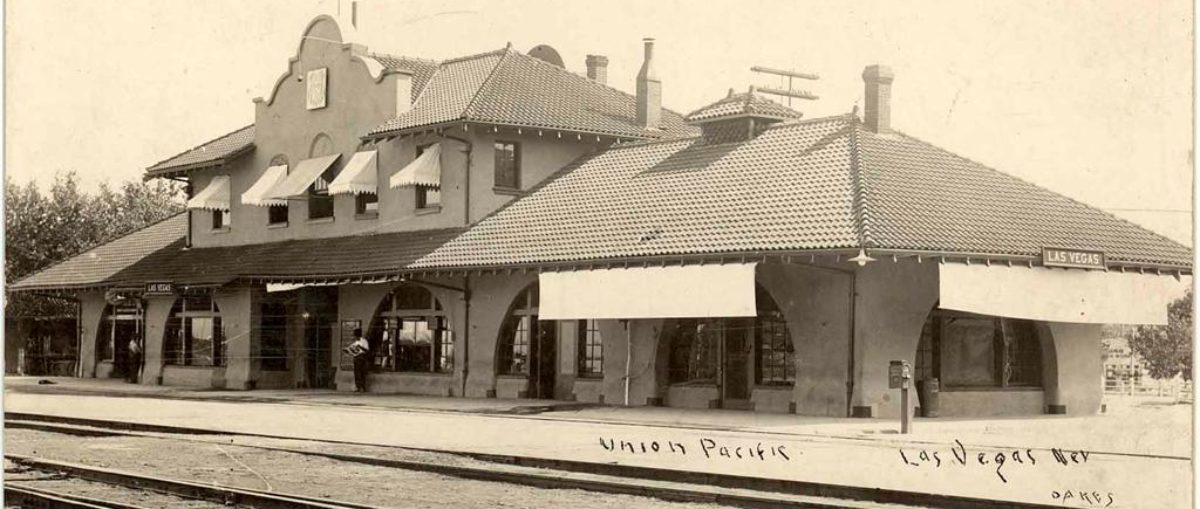Charlotte Perkins Gilman! Finding her in Las Vegas was a fortunte accident. Finding Charlotte Perkins Gilman and her The Yellow Wallpaper…. well, you need to read it for yourself. The article below covers my search for the details of C.P.G’s visit to the small desert community of Las Vegas.
I bumped into Charlotte Perkins Gilman for the first time when working on a story about Las Vegas in 1912. Gilman paid a visit to southern Nevada that year to advance the right of women voting. Still odd to think about that today. And still odd today that most people don’t vote.
Back to Gilman, by 1912 she was a national leader. Through her articles, her books, her public speeches, and her actions, both public and private, she battled against the male dominated business, government and social space of the times.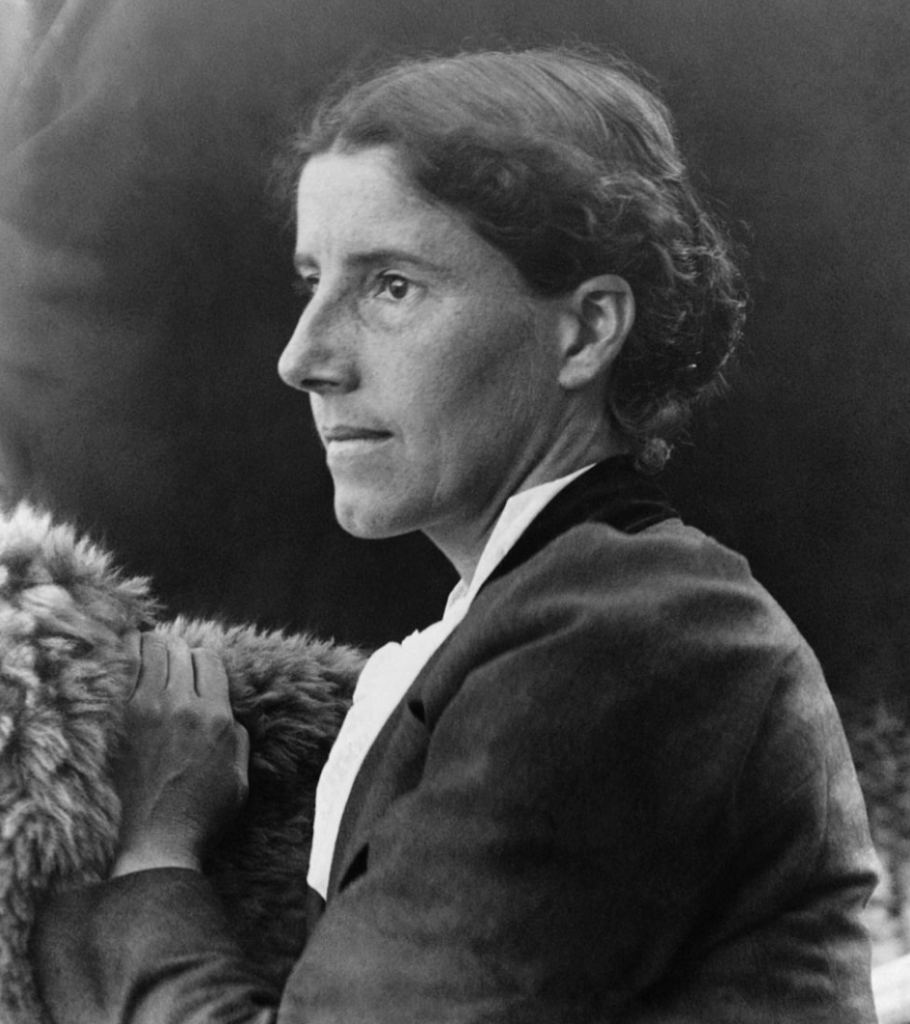
At the time of her Las Vegas visit she was also producing the progressive feminist magazine, THE FORE-RUNNER.
She said change was coming and resistance was futile. And, to define Charlotte Perkins Gilman in a couple of sentences, is also futile. Read a book!

As a young woman, Perkins was an artist. She created images that were used on “trade cards” in the late 1800’s. This one was used by the “Boston Shoe Store” in Providence, Rhode Island.
1912 was a big political year nationally. While every presidential election is historic, 1812 still stands out.
It was a rare four-way contest. Incumbent President William Howard Taft was nominated by the Republican Party with the support of its conservative wing.
Former President Theodore Roosevelt after losing the nomination to Taft created the Progressive Party splitting the Republican vote.
The Democrats had their own problems. It took 46 rounds of voting by delegates before the Democrats selected Woodrow Wilson to be their nominee. In the end, with the support of William Jennings Bryan, he received the nomination.
Bryan, who had run for president three times, was a favorite of Las Vegas voters.
The 4th candidate was Eugene Debs, running under the banner of the Socialist Party of America. By the way, the Socialist party was alive and well in Las Vegas in 1912, and Debs himself had visited Las Vegas.
As a small community, a visit to Las Vegas by any national figure, political or otherwise, usually meant little more than a speech from the platform of the last railroad car.
The Las Vegas stop was not long, about twenty minutes to pick up fuel and food.
In most cases, much of the town would show up at the railroad depot, no matter who the person or political party. Entertainment was hard to find on the northern edge of the Mojave Desert.
When the votes were tabulated in November of 1912, Wilson won the nation, Las Vegas, and Clark County. But both Roosevelt’s Progressive Party and Deb’s Socialist party beat republican Taft in Las Vegas, and Debs got the most votes in Goodsprings.
With Las Vegas’ population estimated at fifteen-hundred, 610 men registered to vote. Of that number 466 voted Las Vegas. Four political parties were active in Clark County including Democrats, progressive, republicans and socialists.
Woodrow Wilson won the national election, with 42% of the popular vote, Roosevelt picked up 27%, Taft 23% and Debs 6%.
The issue of women being able to vote was a major part of the 1912 election. The city had two newspapers, the republican Las Vegas Age and for Democrats, the Clark County Review.
The Age, run by Charles and Delphine Squires, supported the women’s right to vote. The Clark County Review run by Charles Corkhill was opposed to women voting.
While Mrs. Squires supported the right of women to vote, she was a bit put off by Gilman and her supporters; “along about 1912 the whole country seemed to be sieged with suffragists clamoring to be allowed to present their views on the subject.” [i]
Mrs. Squires felt the best way to get the vote, was in the form of a “gift” from men.
“There seemed to be two schools of thought in regard to wimmin’s rights” according to Squires, one group of women who “just had it in for the males of the species and lambasted them on every occasion, which was a queer way to treat the only persons who had it in their power to grant them this great gift which they were seeking.” [ii]
“The other contingent,” Squires said “felt they were physically able to go to the polls and mentally able to cast a vote when they got there.” But Squires said and believed “the less said about the effort to pass a law to allow women the right to vote the better.” [iii]
When the question of women voting was place on the ballot, Squires said women should “just ask their male friends, in the most polite way possible to vote for the measure and that was all there would be to it.” She concluded by saying, “We were thankful that our Vegas women belonged to this second lot.” [iv]
As part of her less said and ask politely campaign, Squires said her group “had been quite fortunate in keeping the many rampant speakers from coming to Vegas to air their views.”
This changed in early October of 1912 when Squires said she “received a telegram from Miss Ann Martin of Reno who was the head of the suffrage movement in Nevada, informing me that she was sending Mrs. Charlotte Perkins Gilman, a nationally known suffrage speaker and incidentally a niece of the Rev. Henry Ward Beecher, the noted Brooklyn divine, to Las Vegas and would I get her a hall. Miss Martin had probably selected me because I was president of the Mesquite Club and there was no suffrage organization in town.” [v]
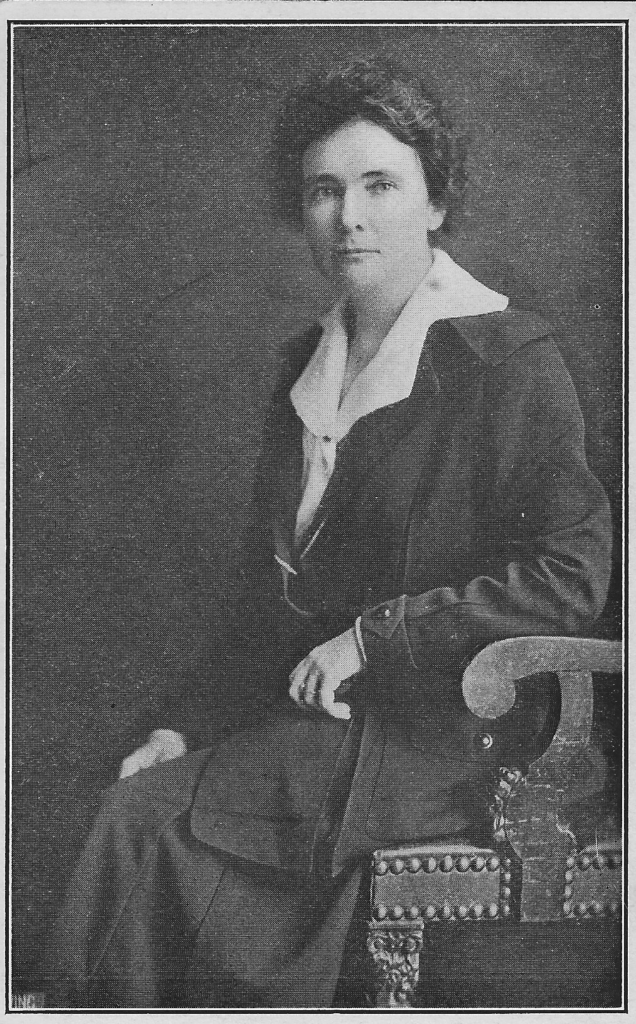
A campaign post card when Anne Martin ran for the U.S. Senate in Nevada in 1918. She was the first woman in the United States to run for the U.S. Senate.
Squires said she had a problem finding a lecture hall for Perkins as Martin had requested.
“As there were no funds available” Squires said, “I asked the school board if we might use the school house. They were willing and told the principal, A.S. Henderson, to have the janitor have the building warm and lighted. Then I put a notice in the “Age” and we were all set.” [vi]
Delphine added, “However, I was very uncomfortable because I was sure she would say something which would make the men mad, but consoled myself with the thought that in all probability there would not be many men present. Those who would show up would be dragged there by their wives.” [vii]
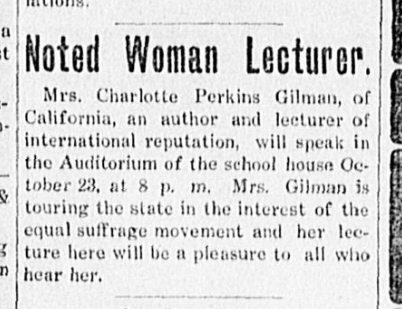 The notice Mrs. Squires put in the Las Vegas Age is found on page five of the October 12, 1912 edition. The notice, titled “Noted Woman Lecturer,” said Gilman was a “lecturer of international reputation” and it “will be a pleasure to all who hear her.” [viii]
The notice Mrs. Squires put in the Las Vegas Age is found on page five of the October 12, 1912 edition. The notice, titled “Noted Woman Lecturer,” said Gilman was a “lecturer of international reputation” and it “will be a pleasure to all who hear her.” [viii]
With the general election less than a week away, politicians focused on a last push for voters. With no radio, television, or internet, and Las Vegas with just two weekly newspapers, it was handbills and hand shaking.
Clark County and Las Vegas voters were still up for grabs as no one party appeared to dominate the electorate.
Mrs. Squires remembered one day late in the week of October 12, “Ed W. Clark and W. E. Hawkins appeared at my front door with the news that they had just received a wire from our U.S. Senator, Francis G. Newlands, telling them that he would be in Vegas,” on October 23, the same day Gilman was set to speak.” [ix]
The two men, according to Mrs. Squires, “were very apologetic, fearful that we woman might think they had done it all on purpose.” [x]
Mrs. Squires said the two men “offered to let Mrs. Gilman have 15 minutes of the senator’s time on his platform.” She added “I thought it was very generous of them.” The senator and Gilman were now set to speak at the Majestic Theatre, owned by the Squires’ family.
Squires said she accepted the change without contacting Gilman because “I knew there would be a fine audience of men as the senator was very popular, and I also thought that 15 minutes was long enough for any woman to talk on one subject.” [xi]
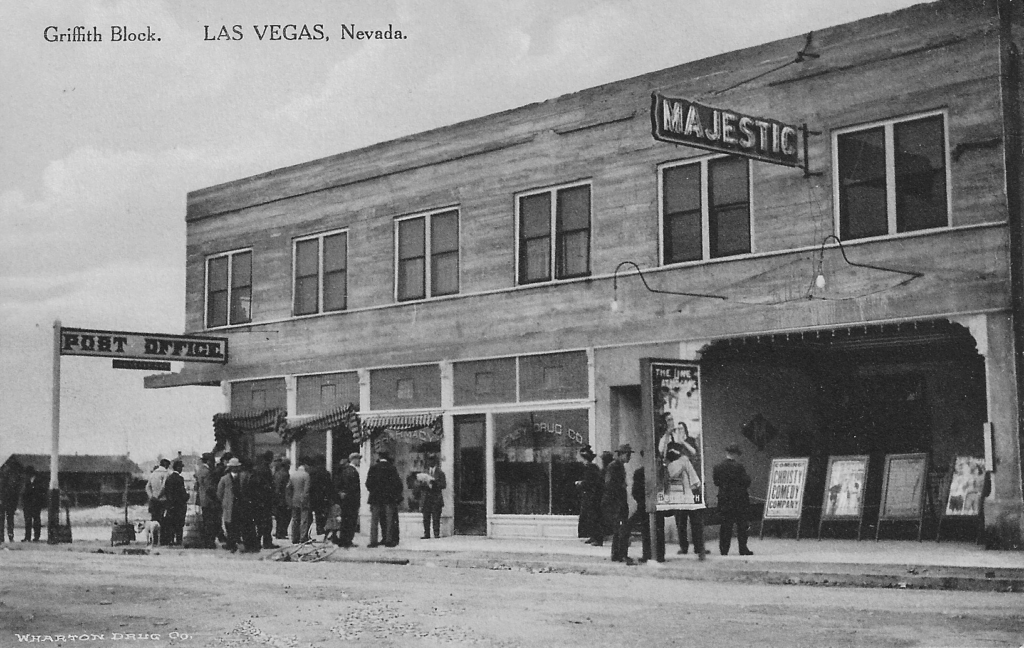 The Majestic Theatre where Charlotte Perkins Gilman was set to speak. This 1912 post card shows the building on the southwest corner of Second and Fremont, now the Golden Nugget Hotel-Casino.
The Majestic Theatre where Charlotte Perkins Gilman was set to speak. This 1912 post card shows the building on the southwest corner of Second and Fremont, now the Golden Nugget Hotel-Casino.
Once Corkhill got word of the big Democratic rally and that Gilman would be part of the political fundraiser, he wrote a front page story for his October 19 issue.
Under the title, “The Big Event of the Campaign,” the Corkhill exclaimed, “the Democratic party will present to the people of Las Vegas an array of forensic talent never before equaled in this part of the state.” [xii]
The Clark County Review story went on to report, “the county Democratic committee has arranged to give a hearing to Charlotte Perkins Gilman the noted authoress and lecturer, who is touring the state in behalf of the cause of women’s suffrage, under the auspices of the state organization. It was learned that Mrs. Gilman was to appear here the same night as the Democratic speakers, and the Mesquite Club, who had under taken to defray a portion of the expenses as a matter of courtesy has acceded to the plan of the Democratic committee to give all a hearing before the same audience.” [xiii]
Then, oddly supportive of Gilman, Corkhill published, “And the women, whether they believe in Mrs. Gilman’s work or not, should not fail to hear her, as she is one of the brightest, brainiest and most eloquent advocates of the cause she espouses who has ever appeared publicly in this or any other country” [xiv]
The Squires in the October 19th issue of the Las Vegas Age in their story about the Democratic campaign event called Gilman a “special attraction.” [xv]
Gilman arrived in Las Vegas on October 23, not knowing her event had been changed. When she found out she had been booked as a “special attraction” at a Democratic fundraising event she was upset and said no!
Mrs. Squires recalled the moment Gilman arrived in Las Vegas. Squires said she and her husband “went to the depot to meet the lady in question and had no difficulty in spotting her. All of those women seemed to have the same idea about clothes and that was to dress as nearly like a man.” [xvi]
Mrs. Squires said she walked over Gilman and introduced herself and husband and. Squires said “we started for the Nevada Hotel where I had engaged a room for her. I was quite eager to tell her the good news of the grand audience she was to have. But when I did she didn’t seem very much impressed and started to argue.”
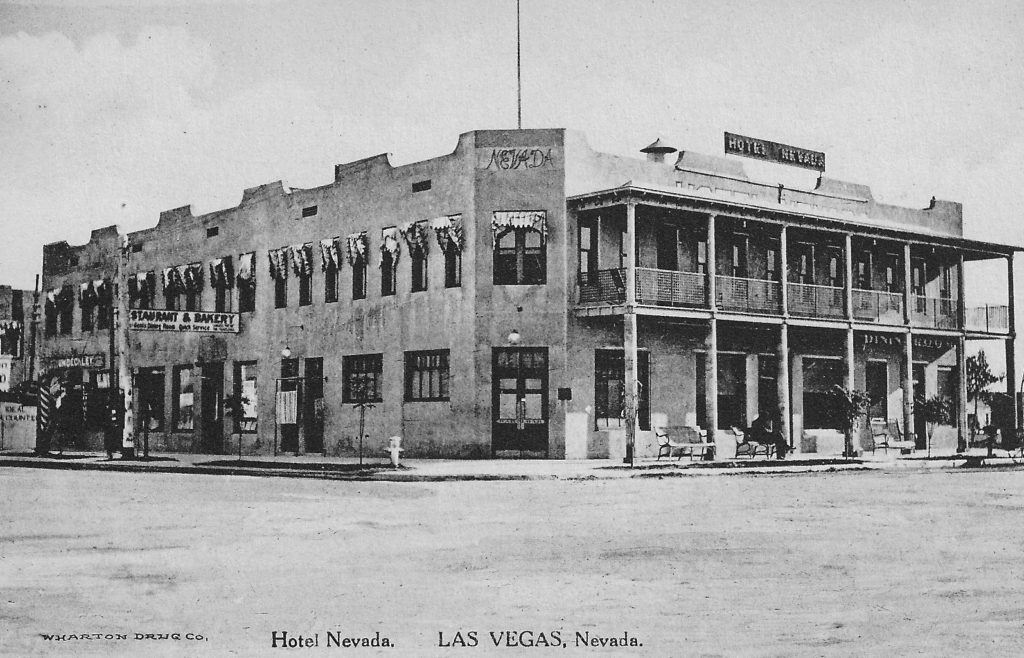
A 1912 post card of the Nevada Hotel, now the Golden Gate Hotel and Main and Fremont Streets.
Squires said she and her husband continued to argue with Gilman “ but to no avail and she finally stopped at the door of the hotel and, as mad as a hatter, delivered this ultimatum: “I will not speak from Senator Newlands platform. I’ll either speak from my own or not at all.” [xvii]
Mrs. Squires said “by this time my dander was up and so I said: ‘Well, as far as I’m concerned you needn’t speak at all,’ and we left.” [xviii]
Gilman kept her word and did not attend the Democratic fundraiser. She found a street corner a half a block away to hold her rally.
The Republican Squires, who owned the theatre where the Democratic rally was being held chose not to be part of Gilman’s event: “we went to hear Senator Newlands” who it turned out did not show up either.
The details of what Gilman said at her event are unknown as neither newspaper covered the speech. Mrs. Squires would recall: “We heard later that Mrs. Gilman spoke from the back of a car at the corner of First and Fremont Streets to just a handful of men, and when I heard that they had heckled her I knew she had said something she should have left unsaid and was glad she had decided as she had” not to speak at the big Democratic rally. [xix]
Sadly, neither Las Vegas newspaper, the Age or the Review covered Gilman’s Las Vegas rally leaving to history only what Squires would later record in her oral history.
But what is available, Gilman’s thoughts after her visit to Nevada.
Gilman wrote, “Nevada should show the world that it is not ruled by the desires of its desultory transient bachelor residents, and those who cater to such desires; but by the real citizenship, the men who call Nevada “home,” who live there, work there, marry and raise families there, building up the country.” [xx]
Gilman continued, “There are those who wish to keep Nevada “wide open” — a national resort for all the popular vices, but there are others who do not wish their State to be the possible “tenderloin” of the West; the not impossible “red-light district” for our whole country.” [xxi]
She concluded ”Those who value permanent, legitimate prosperity more than transient illegitimate popularity; those who wish to move at the head of the procession instead of sitting still in the rear, will vote for equal suffrage in Nevada.” [xxii]
Not only did Gilman not show up at the Democratic rally in Las Vegas in October of 1914, neither did Senator Newlands.
The Las Vegas Age, under the caption “Democratic Disappointment” printed, Newlands was “ill and confined to his room at Tonopah” and Pat McCarran, running for a seat on the Nevada Supreme Court was “called back to Reno by the illness of his wife.” [xxiii]
Only Democratic candidate running for congress showed up and he spoke for nearly two hours. [xxiv]
And as far as Gilman the newspaper simply said “Mrs. Perkins Gilman had a mix-up with her up state manager and refused to appear.” [xxv]
Corkhill, in the next issue of his Clark County Review, took a less hospitable approach: “Mrs. Gilman, the woman suffrage talker, who was given an opportunity to appear before the big audience more as a matter of courtesy than anything else, was pouting over something that she anticipated was going to happen in Tonopah, and said if she couldn’t do so and so in Tonopah she just wouldn’t do so and so here; so there! And nobody begged her to, so she didn’t” [xxvi]
Corkhill was opposed to women voting, and was not fond of President Theodore Roosevelt. The newspaperman wrote a couple of months before Gilman arrived, “that name “Roosevelt” never did sound right for a President of the United States.” [xxvii]
After her rally, Gilman walked a block west to Main and Fremont Streets to her hotel, where she got ready for an early morning train ride to Goldfield, and her next rally.
At this point the story is picked up by Florence Boyer the daughter of Mr. and Mrs. Squires.
In her oral history, Mrs. Boyer recalled the morning after the Democratic rally her Mother and six other women were heading to Goldfield for a meeting of the State Federation of Women.
The train headed north was mainly a freight operation. Mrs. Boyer said there was one car for passengers and it was “divided into three parts, one for baggage and one for the conductor and a little portion in the back for the passengers.” [xxviii]
Mrs. Boyer said just about the time the train was ready to leave “the door of the depot opened and in walked Mrs. Gilman. Mother said he put her pride in her pocket and went over and spoke to her and introduced her to the club members. Mrs. Gilman was freezing polite and immediately boarded the train. Mother described the scene: “the small compartment was full to overflowing. Mrs. Gilman was in the very back seat, well hidden behind the morning papers.” [xxix]
After a couple of hours on the train, Boyer said her mother who had “brought a wonderful lunch” with her “asked Mrs. Gilman if she wouldn’t like to have lunch with them, and she said she preferred to get off at Beatty and eat her lunch.” [xxx]
When they arrived in Goldfield early in the evening, they were met by their convention host who suggested women hurry because “after dinner there was a special treat for them.”
The “special treat,” of course, was a speech by Mrs. Gilman. After the speech the women they were taken to the stage and introduced to her Gilman. No record of that meeting has been uncovered.
From Goldfield Mrs. Squires headed for Reno to meet an old Las Vegas neighbor. When the woman met Squires at the Reno train depot she hurried her to the Century Club to hear a special speaker.
The speaker, of course, was Charlotte Perkins Gilman. Mrs. Boyer said her mother was introduced to Mrs. Gilman again. “At this point it really was quite funny.” She said her mother and Mrs. Gilman had quite the laugh.
Three meetings, two speeches and a laugh left a lasting memory on Mrs. Squires and her daughter. [xxxi]
Gilman would go on to speak in Reno several times over the next few years, but her one appearance in Las Vegas was her last.
The important full story of Charlotte Perkins Gilman and her impact, her strong connection to Nevada is still to be written. Details of her Nevada visits and thoughts are scattered over several universities.
This blog ends with her poem titled “A Nevada Desert.” In her autobiography Gilman wrote of her poem: “the little “Nevada Desert” is good of its kind, thought T.B. Aldrich sent it back from the Atlantic, with the remark that it needed a spot of color without which no picture was perfect. He had not seen Nevada.” [xxxii]
“A Nevada Desert,” by Charlotte Perkins Gilman
An aching, blinding, barren, endless plain;
Corpse-colored with white mould of alkali;
Hairy with sage-brush, slimy after rain,
Burnt with the sky’s hot scorn, and still again
Sullenly burning back against the sky.
Dull green, dull brown, dull purple, and dull grey
The hard earth white with ages of despair;
Slow-crawling, turbid streams where dead reeds sway;
Low wall of sombre mountains far away,
And sickly steam of geysers on the air.
P.S. Charlotte Perkins Gilman and her trade cards. Trade cards were popular in the United States in the late 1800’s. The cards were used by business to promote their products. Sometimes simply used as a calling card of sorts, other times sets of cards were created by the companies in hopes that individual would buy their products to get the new card. Artists were hired to create sophisticated images, and stories. Early in life Gilman was hired to create art for trade cards. Kevin Mac Donnell though dedicated research has uncovered the documentation that identifies Gilman’s art work. Thus began my search for original examples of Gilman trade card artwork. A slide show of the result of searching through antique stores, book stores, as well as on and off line is coming up in a separate blog. Here is one example and a link to Mac Donnell’s work.
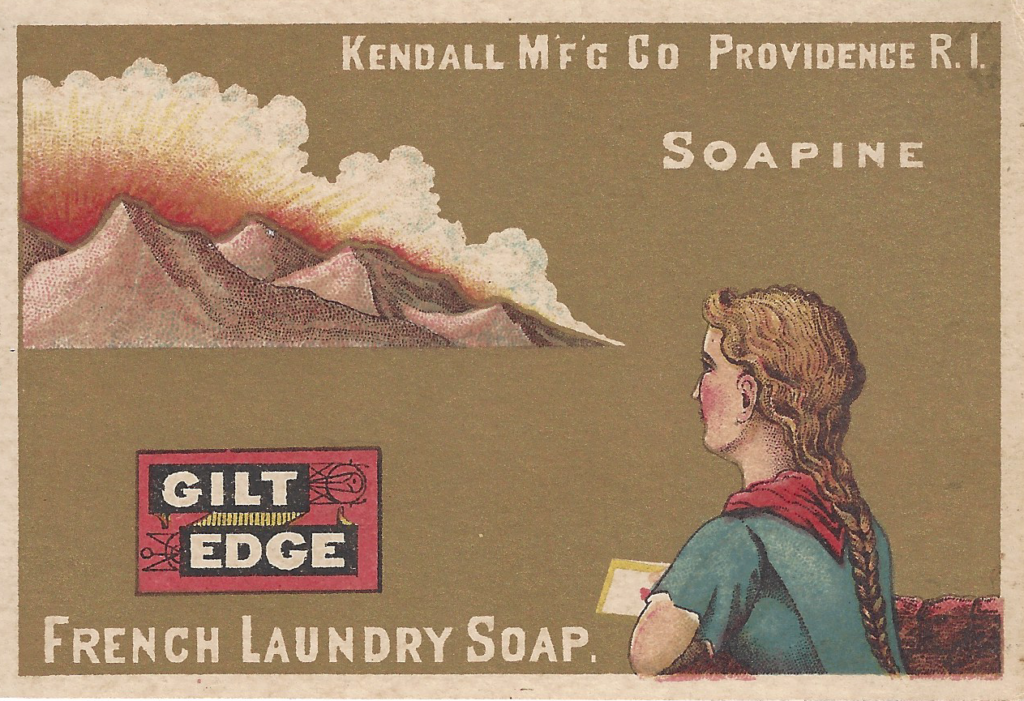
https://www.abaa.org/member-articles/charlotte-perkins-gilmans-trade-card-designs
[i] “Nevada Observations by Delphine Squires,” December 18, 1954, Fabulous Las Vegas magazine, page five.
[ii] “Nevada Observations by Delphine Squires,” December 18, 1954, Fabulous Las Vegas magazine, page five.
[iii] “Nevada Observations by Delphine Squires,” December 18, 1954, Fabulous Las Vegas magazine, page five.
[iv] “Nevada Observations by Delphine Squires,” December 18, 1954, Fabulous Las Vegas magazine, page five.
[v] “Nevada Observations by Delphine Squires,” December 18, 1954, Fabulous Las Vegas magazine, page five.
[vi] “Nevada Observations by Delphine Squires,” December 18, 1954, Fabulous Las Vegas magazine, page five.
[vii] “Nevada Observations by Delphine Squires,” December 18, 1954, Fabulous Las Vegas magazine, page five.
[viii] “Noted Woman Lecturer,” October 12, 1912, Las Vegas Age, page five.
[ix] “Nevada Observations by Delphine Squires,” December 18, 1954, Fabulous Las Vegas magazine, page five.
[x] “Nevada Observations by Delphine Squires,” December 18, 1954, Fabulous Las Vegas magazine, page five.
[xi] “Nevada Observations by Delphine Squires,” December 18, 1954, Fabulous Las Vegas magazine, pages five and forty-one.
[xii] “The Big Event of the Campaign,” October 19, 1912, Clark County Review, page one.
[xiii] “The Big Event of the Campaign,” October 19, 1912, Clark County Review, page one.
[xiv] “The Big Event of the Campaign,” October 19, 1912, Clark County Review, page one.
[xv] “Democratic Blow-Out,” October 19, 1912, Las Vegas Age, Page one.
[xvi] “Nevada Observations by Delphine Squires,” December 18, 1954, Fabulous Las Vegas magazine, page 41.
[xvii] “Nevada Observations by Delphine Squires,” December 18, 1954, Fabulous Las Vegas magazine, page 41.
[xviii] “Nevada Observations by Delphine Squires,” December 18, 1954, Fabulous Las Vegas magazine, page 41.
[xix] “Nevada Observations by Delphine Squires,” December 18, 1954, Fabulous Las Vegas magazine, page 41.
[xx] “Why Nevada Should Win Its Suffrage Campaign in November,” by Charlotte Perkins Gilman, August, 1914, Out West magazine, pages 73-74
[xxi] “Why Nevada Should Win Its Suffrage Campaign in November,” by Charlotte Perkins Gilman, August, 1914, Out West magazine, pages 73-74
[xxii] “Why Nevada Should Win Its Suffrage Campaign in November,” by Charlotte Perkins Gilman, August, 1914, Out West magazine, pages 73-74
[xxiii] “Democratic Disappointment,” October 26, 1912, Las Vegas Age, Page one.
[xxiv] “Democratic Disappointment,” October 26, 1912, Las Vegas Age, Page one.
[xxv] “Democratic Disappointment,” October 26, 1912, Las Vegas Age, Page one.
[xxvi] “Clay Talsman Scores big Hit,” October 26, 1912, Clark County Review, Page one.
[xxvii] Editorial, April 12, 192, Clark County Review, page two.
[xxviii] “Las Vegas: My home for Sixty years” by Florence M. Boyer, 1967, Oral History project, University of Nevada Reno, page 98-99.
[xxix] “Las Vegas: My home for Sixty years” by Florence M. Boyer, 1967, Oral History project, University of Nevada Reno, page 98-99.
[xxx] “Las Vegas: My home for Sixty years” by Florence M. Boyer, 1967, Oral History project, University of Nevada Reno, page 98-99.
[xxxi] “Las Vegas: My home for Sixty years” by Florence M. Boyer, 1967, Oral History project, University of Nevada Reno, page 98-99.
[xxxii] “The Living of Charlotte Perkins Gilman,” An Autobiography by Charlotte Perkins Gilman,” 1935, The University of Wisconsin Press, Madison, Wisconsin, page 111.
